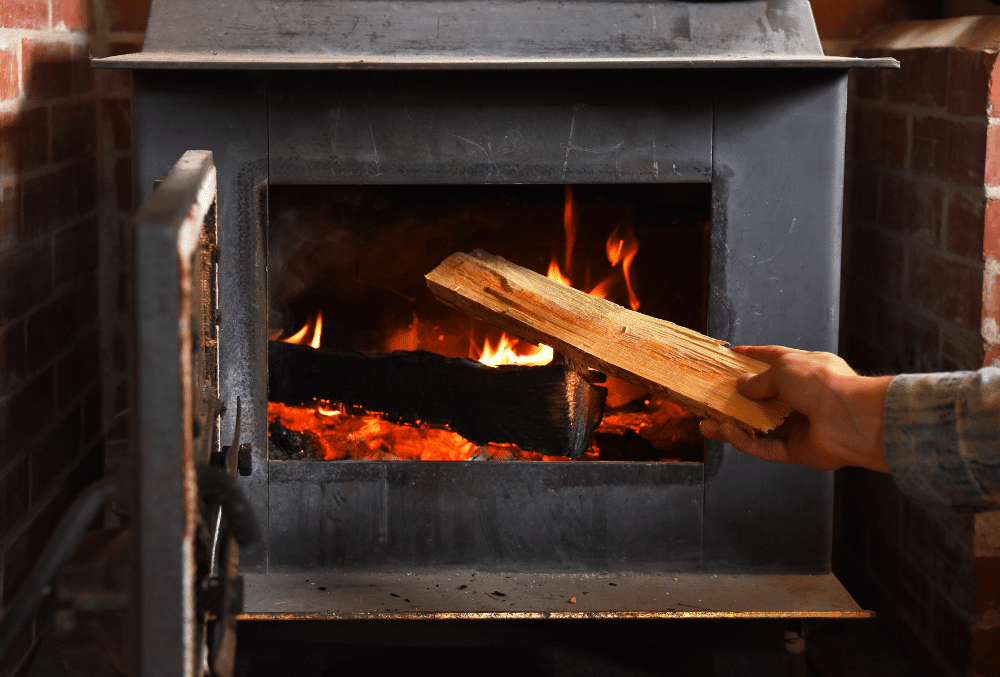Wood Stove Chimney Maintenance 101
March 20th, 2023
If your house is located in an area that experiences intense winter storms, your home may likely have a woodstove chimney. While these classic home additions may offer unparalleled warmth on a cold night, they also come with a long list of crucial upkeeping maintenance tasks. Areas with extreme winter weather in Northern Ontario, can fall victim to power outages, caved-in roofs, frozen or burst pipes, and chimney malfunctions. Avoid residential damages and personal injury or harm by ensuring your chimney is adequately cared for year-round.
Winters in Ontario can be extensive and extreme, with many cities seeing an average annual snowfall level of 112 inches. Residents need to be all the more cautious with chimney maintenance. The following tips will help keep your home and family safe and warm all season.
What You Burn Matters to Your Stove and Chimney
Experts warn an essential thing to remember when dealing with a wood stove is it is supposed to be for wood only. To keep your woodstove chimney in pristine condition, and allow for easier cleaning, avoid burning anything that is not pure, untreated wood. A list of things to never burn in your woodstove chimney is as follows:
- Trash
- Artificial logs
- Driftwood
- Treated wood
Remember don’t burn anything that will potentially contain sulfur, lead, zinc, or plastic, as these will damage the catalytic combustor inside your woodstove chimney. The fumes produced from burning these items are dangerous to those who may inhale them.
Keeping the wood only rule in mind will help avoid many headaches with your stove and chimney in the future. If you are looking to get more heat out of your wood stove, try burning seasoned wood. Unlike artificial logs claiming to do the same, dried and seasoned wood puts maximum heat while avoiding dangerous gases. Avoid freshly green wood, as it holds a lot of moisture that must first burn off in the fire before any natural heat is produced for your home.
Consistency on Maintenance
One of the most crucial aspects of woodstove chimney upkeep is the chore of consistency. The best thing you can do for your chimney and stove is to keep up with them year-round. There are things you can do throughout your chimney uses that will make the maintenance process go far more smoothly as the seasons change:
- Build small, scorching fires inside your stove. A new stove and chimney can be as unfortunate as an overused one.
- Keep your home well insulated. If your home holds warmth well, you will use your chimney and stove less, adding additional years to your chimney’s lifespan.
- Your stove’s air vents should be kept clear by consistently removing the ash buildup, which should be minimal if you using seasoned wood.
- Have your woodstove and chimney inspected before each winter.
Although it may seem taxing, keep in mind taking care of your woodstove chimney now will keep it lasting years longer than if you treat and maintain it only once per year.
Hiring a Professional Chimney Sweep
For best practice, have all your chimneys, fireplaces, and wood-burning stoves checked by a professional annually. A malfunctioning chimney can be extremely dangerous if a fire is lit beneath it. You run the risk of a fire spreading outside the perimeter and risking carbon monoxide buildup, which can be disastrous for anyone inside the home.
The chimney sweep will remove the creosote buildup from your woodstove or fireplace, which can be hazardous if not disposed of. Your chimney may also be home to wildlife. Birds, squirrels, raccoons, and chipmunks all have a habit of seeking shelter inside chimneys.
If you have a wood stove chimney in your vacation home, always remember to close your flue, along with any hearth doors. Unattended drafts throughout the colder months can cause your heating bill to skyrocket as the electric heating goes up and out the open chimney flue.
Woodstove Chimney Cleaning
Keeping your woodstove and chimney clean is important for keeping your space clean, but also crucial to your family’s safety. Half the enjoyment of starting a fire in your woodstove is sitting back, relaxing, and watching the flames. However, that can be difficult if black soot has overcome your stove and chimney where you cannot see the flames with a clear view.
Glass Door
The majority of woodstoves built in the last 40 years have a ceramic glass panel in the door for an air wash system. With a narrow slit at the top of the glass, airflow makes its way down to the flames, stoking it and keeping the fire going. Because of this design, the air creates a barrio between the glass door and the fire, eliminating much of the soot from sticking to the glass. However, the soot remaining on the glass can be tricky to eradicate. To rid yourself of your remaining soot, follow these suggestions:
- Wait until your wood is in the charcoal stage before pulling it out and letting it cool completely.
- Pick up the now cool piece of charcoal, dampen the charcoal with water, and rub it on the blackened glass. You will see the black soot slowly disappear as you rub the damp charcoal.
- Remove the loose soot with a damp paper towel to finish the job.
Flue
The flue of your chimney can become a fire hazard quickly if debris from a creosote buildup is present. As stated earlier, it is recommended you continually perform upkeep on your woodstove and chimney throughout the year. However, if your last maintenance was performed quite a while ago, you may want to check your flue for creosote debris.
Wait until your woodstove and chimney are completely cool, then begin tapping on your flue, listening for falling debris coming from a creosote buildup. If you can hear bits of debris falling, do not light your stove again until the problem has been rectified. You must clean the debris and creosote buildup yourself or hire a professional to do so for you. Ignoring this issue can put both your home and family in unnecessary danger.
As you use your woodstove and chimney throughout the year, there are things you can add to your fire to help fight the creosote buildup, thereby making your chimney safer and cleaner. There are creosote-eliminating logs that can be used in an already burning fire. There are also creosote combating powders you can add to the flames of your wood stove. However, even with these helpful products, you must clean sweep your flue at least once a year.
Surface Stove
Before cleaning your stove’s surface, always ensure it is completely cool. Then, you can add warm water and detergent to the top. Once the soap and water have dried, apply a small layer of stove polish paste to the surface, then rub it firmly with a paper towel while removing any excess. Lastly, light a fire on the stove to allow the polish to cook and harden. While this will help protect and maintain your stovetop, it will also fill your house with fumes, so keep the windows open.
Final Thoughts
The winter months are always more pleasant with the crackling warmth from your woodstove. However, those cozy nights may be interrupted if you fail to maintain and clean your chimney and stove annually. While maintenance greatly reduces your risk of fires, accidents can still happen. It is vital to have the proper coverage through your homeowners insurance in case of an accident. The dedicated team at Duliban Insurance will work alongside you to find an insurance policy that fits your needs. Contact us at 1-855-DULIBAN, our team will be happy to assist you.











